|
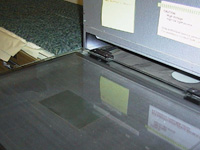
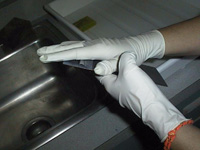
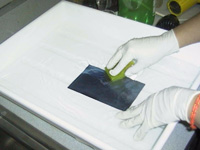
|
Liquid
ImagOn for Reworking the Plate
- A
liquid ImagOn emulsion is made by stripping the ImagOn emulsion from
its peel back layer and Mylar protective backing and dropping this
emulsion in a light proof jar containing 99% rubbing alcohol (the 70%
isopropyl alcohol also works but takes longer to dissolve).
- Make sure that both plastic surfaces of
the ImagOn emulsion are removed and that only the raw ImagOn emulsion
is placed in the alcohol.
- This is one way to use ImagOn off-cuts.
The ImagOn emulsion is added to the rubbing alcohol until a syrupy
consistency is reached. The alcohol takes several hours to dissolve
the ImagOn emulsion.
|
|
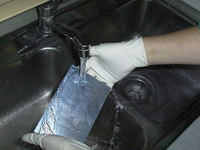
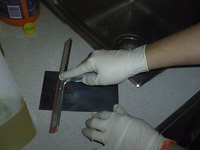
|
Reworking the dark
areas of the plate
- To rework the dark areas of the plate
the plate must be thoroughly cleaned with vegetable oil and then with
a water and magnesium carbonate solution until all greasy ink residues
are removed. After the plate has dried the liquid ImagOn emulsion can
be painted directly on to those areas of the plate that represents the
darkest areas of the image. More than one layer can be applied. After
the ImagOn has dried the Aquatint Screen is positioned on top of
the plate and exposed, developed and light-hardened in the same
manner in which the plate was originally made. (See the description
under the WD-H-Type)
|
|
|
Reworking the light areas of the plate
- One simple way to rework the lighter
areas of the plate is to use various coarseness of wet-and dry
sandpaper. By using the dry sanding method this sandpaper is wrapped
around a burnishing tool to facilitate burnishing small areas of the
plate.
|
|
|
Other techniques for reworking the plate
- Provided there is no oil or ink residue
on the surface of the ImagOn plate Hunt Speedball water soluble screen
filler 4720 can be painted directly onto the surface of the ImagOn
(see the Mezzo Intaglio Type).This technique adds a relief dimension to
your image and has great image adjusting abilities according to how
thick the screen filler is applied. Printing this type of plate in
intaglio and relief simultaneously presents yet another image making
option.
- At this point it is easy to see how
collograph techniques can be applied such as using water based glues
sprinkled with salt to sticking textured materials directly onto the
plate. Of course the option also exists to start with a collograph
plate or in fact any etched plate and selectively apply small or large
areas of ImagOn film to the surface thus opening up the possibility to
rework virtually any plate. When applying ImagOn onto an irregular
surface the alcohol concentration of the lamination spray should be
increased to 50%. Although a plate can be used immediately best
results are achieved by leaving the adhered layer of ImagOn on
the plate for a minimum of six hours before exposing it to the image.
Reworking the
Plate with the Stripping Solution
Multiple Plate and Image Superimposition
|
|
|
|





